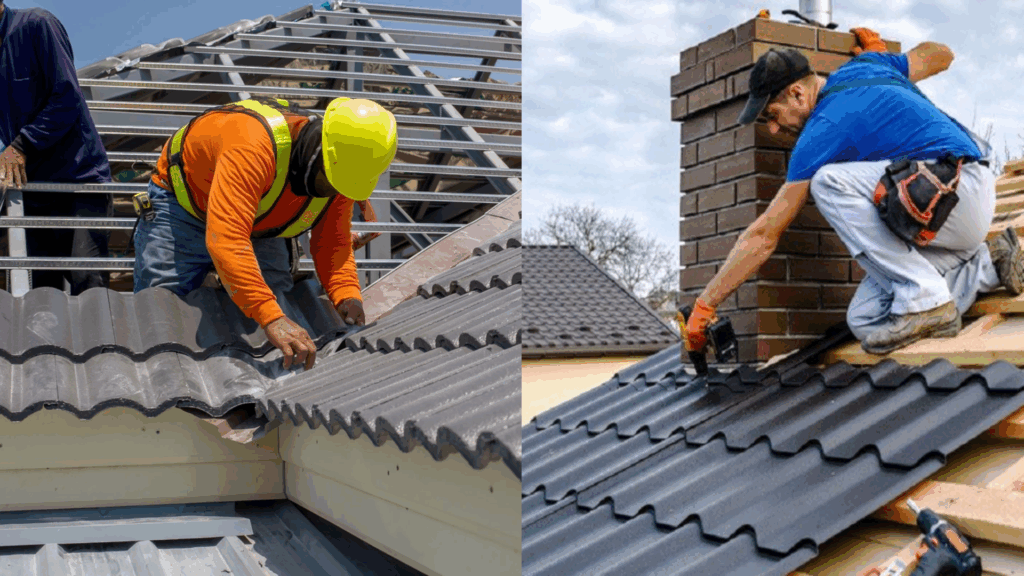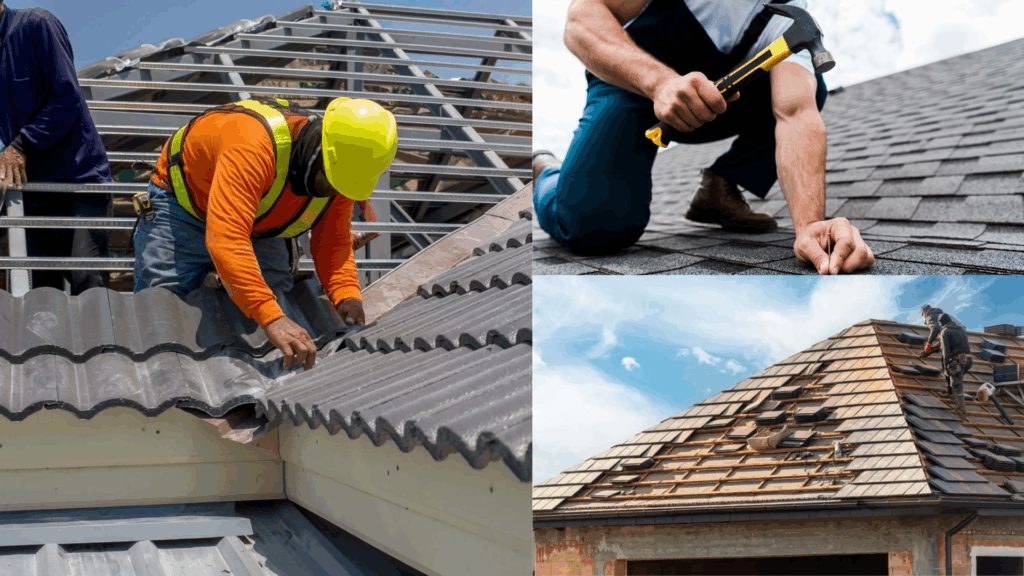When it’s time to replace your roof, I know it can be difficult to decide if staying at home is the best choice.
The noise, safety concerns, and disruption can make the process feel overwhelming. It’s natural to wonder if staying home will be comfortable or if it’s better to leave while the work is being done.
In this blog, I’ll help you navigate this decision by breaking down the pros and cons of staying home during roof replacement. I’ll cover the potential challenges and offer tips on how to prepare if you decide to stay.
Additionally, I’ll provide some alternative options for those who prefer to leave the house during the project.
By the end of this guide, you’ll have all the information needed to make an informed decision for yourself.
What to Expect During a Roof Replacement?
Before deciding if staying home is a good idea, let’s first look at what a roof replacement typically involves. This will help you understand the level of disruption you can expect.
The process of replacing your roof usually includes several steps:
- Inspection: Before the replacement starts, a roofing contractor will inspect the existing roof to determine its condition and identify any issues.
- Tearing Off the Old Roof: This involves removing the existing shingles, tiles, or other roofing material. It can be a noisy process as workers will be using tools like hammers, pry bars, and forklifts.
- Preparing the Roof Deck: After the old roof is removed, the decking (or the foundation of the roof) is inspected for damage. If needed, repairs will be made.
- Installing New Shingles or Roofing Materials: This is when the new shingles or roofing material is applied. It may also involve sealing the roof and adding additional features like vents or skylights.
- Clean-Up: Once the installation is complete, the roofing crew will clean up any debris and remove old materials from your property.
Factors That Could Affect the Decision to Stay Home

Several factors, such as noise, safety concerns, dust, and daily disruptions, play a key role in deciding whether to stay home during a roof replacement.
1. Noise Levels
One of the most significant factors to consider is the noise level during roof replacement.
With tools like hammers, power drills, and forklifts, there will be plenty of noise throughout the day.
This can be especially disruptive if you have children, pets, or work from home.
The noise might not be constant, but it will occur at various points during the day and can last for hours.
2. Safety Concerns
Roof replacement is a high-risk job due to the height and heavy materials involved. While professional roofers are experienced, accidents can still happen.
If you have young children or pets at home, it’s crucial to keep them away from the work zone.
Roofing contractors typically cordon off the area, but maintaining safety is a key factor in deciding if it’s best to stay home or leave during the process.
3. Dust and Debris
Along with the noise, roof replacement brings a lot of dust and debris. When old roofing materials are removed, small pieces can end up on your property, even if tarps are used.
If you have respiratory sensitivities, staying home could be uncomfortable due to dust in the air.
The clean-up process may help, but it’s still worth considering how much mess you can handle before making your decision.
4. Disruption to Daily Activities
Roof replacement can affect your daily routine more than just with noise.
The workers may access parts of your home, such as the attic or garage, which may be off-limits during the project.
It can also cause disruptions in your ability to park or use your driveway.
You might need to relocate to another area of your home, making it harder to carry on with your normal activities.
5. The Length of the Project
Most roof replacements take between one and three days, but delays can happen due to weather or unforeseen issues.
If you’re considering staying at home, you’ll need to weigh if you’re comfortable with the disruption over the extended period.
A longer project might make staying at home more challenging, especially if you need to continue your routine while the work continues.
6. Comfort and Convenience
For many, staying home during a roof replacement can feel uncomfortable. The constant noise, movement of workers, and limited access to certain areas of the house can make it hard to relax.
If you value peace and comfort and don’t want the stress of a busy worksite in your space, you may find it more convenient to leave the house until the project is complete.
Should You Stay Home or Leave During Roof Replacement?
Deciding whether to stay home during a roof replacement depends on your needs and comfort level. Below are some things to consider:
- Comfort with noise and disruption: If you don’t mind the noise, dust, and disruption, and can oversee the project, staying home might be fine.
- Working from home or family needs: If you work from home, have young children, or pets, safety and comfort should be your priority.
- Noise and distractions: The sound of tearing off the old roof, hammering, and power tools can be distracting, especially in a quiet environment.
- Safety hazards: Roofing work involves ladders and heavy equipment, which can be a safety concern for children and pets.
- Peace of mind: If you prefer to avoid the stress and noise, staying somewhere else might be a better option until the project is finished.
The decision ultimately comes down to your priorities, convenience, safety, and comfort.
Pros and Cons of Staying Home During Roof Replacement
When deciding whether to stay at home during a roof replacement, it’s important to consider both the benefits and drawbacks, including noise, safety, and convenience.
| Pros of Staying Home | Cons of Staying Home |
|---|---|
| Immediate Oversight: You can directly supervise the work and ensure everything meets your expectations. | Noise: The constant noise from hammers, power tools, and other equipment can be disruptive, especially if you need a quiet environment. |
| Convenience: If you have a flexible schedule, staying home lets you maintain your routine, with the option to retreat to quieter spaces. | Safety Hazards: Roofing work involves ladders and heavy equipment, posing potential safety risks for children and pets. |
| Security: Staying at home eliminates concerns about the safety of your property or theft during the project. | Dust and Debris: The dust and debris from the project can affect the cleanliness of your home and cause discomfort, especially for those with respiratory issues. |
| Reduced Displacement: No need to make arrangements for temporary accommodation, saving you time and effort. | Disruption to Routine: The construction process can interfere with daily activities, making parts of your home inaccessible and possibly affecting your schedule. |
What to Do if You Decide to Stay Home During a Roof Replacement?
Staying home during a roof replacement requires preparation, including creating a quiet space, maintaining communication with contractors, and ensuring safety for your family.
- Set Up a Quiet Space: Create a designated area away from the noise and disruption where you can work or relax.
- Prepare for Dust and Debris: Ensure the area is protected and stay on top of cleaning to minimize the dust in your home.
- Establish Safety Boundaries: Stay informed about the designated safe zones and keep children and pets away from the work area.
- Communicate with the Contractors: Discuss the schedule and progress regularly to stay updated on the project.
- Manage Your Expectations: Be ready for disruptions and plan accordingly to minimize stress throughout the process.
Conclusion
Deciding to stay home during a roof replacement depends on your comfort level and needs.
While staying home gives you control and oversight, it can also bring disruptions like noise, safety concerns, and dust.
If you have young children, pets, or need a quiet space, it might be better to stay elsewhere.
If you choose to stay, prepare by clearing the area, setting up a quiet space, and keeping a safe distance from the work. If you prefer to stay away, plan ahead for a smooth transition.
If you’re unsure, talk to your contractor for advice on the best option for you.
Frequently Asked Questions
How much does a roof replacement typically cost?
The cost of a roof replacement varies based on size, materials, and location. On average, it ranges from $5,000 to $10,000 or more. For a more accurate estimate, it’s best to get quotes from contractors.
How long does it take to replace a roof?
A typical roof replacement takes 1-3 days, depending on the size of the home, the weather, and the complexity of the job. Larger homes or complicated roofing systems may take longer.
Will my roof replacement affect my home insurance?
In many cases, roof replacement may affect your home insurance premiums. It’s important to contact your insurance provider to see if there are any changes in your coverage or premiums after the replacement.
Can I install a new roof over an old one?
In some cases, roofing contractors can install a new layer of shingles over the existing ones. However, this depends on the condition of the existing roof and local building codes.

